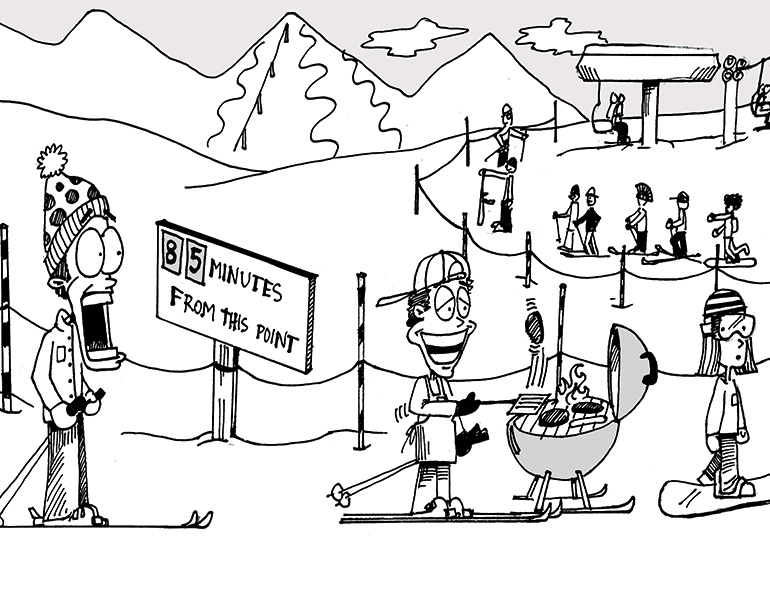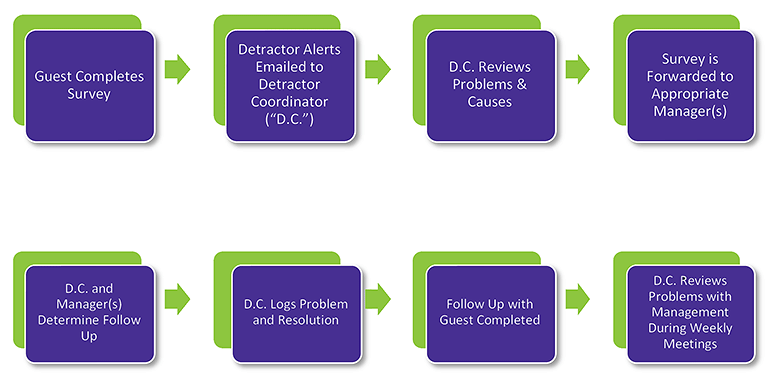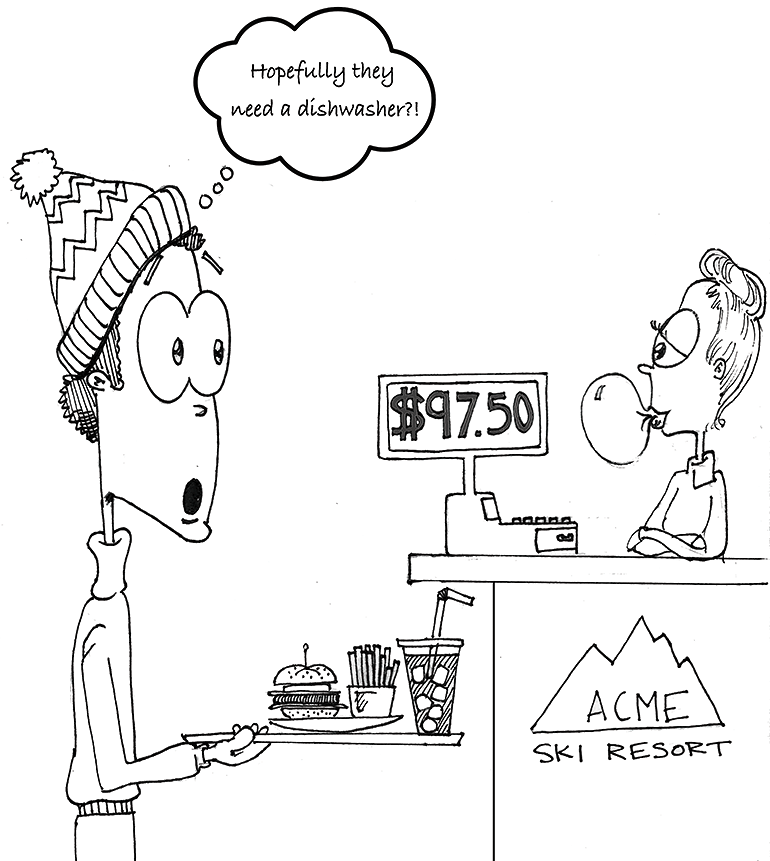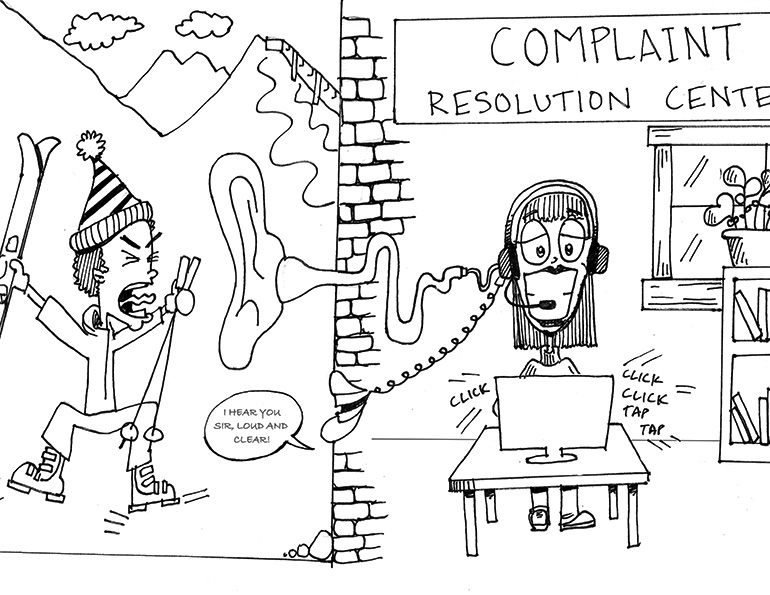Microsoft founder Bill Gates once pointed out that your most unhappy customers are often your greatest source of learning. Ski resorts can benefit from this wisdom, but unfortunately are often in the dark when a customer leaves unhappy. It doesn’t have to be that way, though.
Research conducted by the White House Office of Consumer Affairs shows that only 4 percent of consumers who experience problems will voice their complaints unless specifically prompted to do so. That means for every one guest who complains, 24 others will not, and will depart unhappy. To make matters worse, those unhappy guests may tell an average of nine to 15 other people of their disappointment. So what’s a resort to do?
Why Guests Don’t Complain
Given the complexity of a ski resort visit with its many touch points, it’s not surprising that many guests will have at least one experience to complain about. Disappointment with one or more of these touch points can lead to disappointment with their visit overall, especially if that point is a key driver of the overall visit experience.
The reasons guests don’t voice their complaints more often are legion:
• They may not know how and to whom to complain.
• They may believe it will take too much time and effort.
• They may feel the resort won’t really listen and respond to them.
• They may not feel comfortable complaining in person.
• Worst of all, they may already have decided they will not return to the resort, so why expend the effort?
This reluctance to complain creates a huge missed opportunity for resorts. Research shows that guests who experience problems, and have them resolved to their satisfaction, are more loyal than guests who experience no problems.
Resolving Guest Issues On Site
To overcome this guest reluctance to complain, some resorts are training staff to identify and mitigate unhappy guests. This type of training incorporates a host of ideas, including:
• educating the staff that a complaint represents an opportunity to capture important feedback;
• encouraging and training the staff to identify and intervene with guests who appear to be unhappy;
• providing front line staff with a process to handle difficult guests; and
• empowering the staff to resolve as many problems as possible.
Such training is critical, though surprisingly few resorts utilize it effectively. A few examples from those who do:
No blues at Blue. Pennsylvania’s Blue Mountain Resort has made resolving guest problems on site a priority. The resort routinely trains its staff using its “6 Ways to Enhance the Guest Experience” process. One example: Blue’s “Lend a Hand” training teaches the staff to seek out guests whose body language suggests they are struggling with equipment, rental forms or directions, or have color-coded passes indicating they’re beginners who have taken a lesson and might need help. Also, its team of full-time mountain ambassadors, the “Blue Crew,” are stationed around the resort to provide assistance and direction. They also collects guest contact info on tablets for post-departure email surveying.
Shiny Copper. Copper Mountain, Colo., trains its front-line staff to observe and understand body language so they can identify unhappy guests. The staff then approaches guests to offer assistance.
Interventions everywhere. Similarly, Bretton Woods, N.H., trains its hosts and parking staff to watch for cues to identify arriving guests who appear unhappy for any reason, and then offer these guests the use of a special suite in the lodge for the day. This has proven very successful in making unhappy guests happy. Other resorts, such as Steamboat, Colo., are incorporating the identification of and intervention with guests who are unhappy into seasonal staff training.
Keep It Simple
When a staff member encounters an unhappy guest on site, it’s important to defuse the issue in a positive way. Often, simple tactics are the most effective. Many training programs teach recovery using a multi-step process captured in an acronym. For example:
ACKNOWLEDGE
LISTEN
EMPATHIZE
RESOLVE
THANK
Tahoe Training Partners, a California company specializing in HR solutions and innovative training, offers a very similar approach, a four-step “LAST” (Listen, Apologize, Solve and Thank) process. Laura Moriarty, an executive coach at Tahoe Training Partners, likes to keep it simple. She says recovery training is based on asking the guest one easy question: “How can I make this right for you?” The specific solution is based on the severity of the problem.
Post-Departure Surveys
Post-departure surveys are perhaps the most effective method of identifying unhappy guests. These include not only at-risk detractors—those guests rating their “likelihood to recommend” the resort 6 or below—and the reasons for their low ratings, but also other guests with less serious causes of dissatisfaction based on their answers to open-ended questions. This information enables the staff to recover with those guests, too, and retain their loyalty. For that reason, many resorts extend their outreach beyond unhappy guests to visitors who are “passives” and even to promoters of the resort, too.

That said, most resorts that follow up promptly and efficiently with their detractors would avow that these recovery efforts alone save far more revenue than the expense of the entire guest feedback program.
Recovery is Critical
Why is recovery with survey respondents so important? Unresolved complaints lead to more detractors and fewer promoters. This has a direct impact on repeat and referral revenues, since promoters ski and refer a resort more often than passives, and passives ski and refer a resort more often than detractors. Reaching out to survey respondents and recovering with them has the following specific benefits:
• It shows you’ve listened to their feedback, taken it seriously, and are committed to enhancing their experience.
• You can apologize.
• You can ask follow-up questions to better understand the detractor’s issues and identify root causes.
• It enables you to share the detractors’ additional feedback with the appropriate members of your team.
• Your efforts may dissuade the detractor from completing a negative online review—85 percent of negative word-of-mouth comes from detractors.
• If the detractor has already posted an online review, your recovery efforts may prompt him or her to update the review with your positive actions.
• The more detractors you identify and recover, the greater the revenue saved.
Basic facts to keep in mind:
• When survey respondents are asked their likelihood to return to the resort, only 10 percent of detractors indicate they will definitely return, compared to 84 percent of promoters.
• Promoters are responsible for 85 percent of positive word of mouth, while detractors are responsible for 85 percent of the negative word of mouth.
Without successful intervention, many detractors will not return or will return less often. Plus, detractors are at least twice as likely to talk about their negative experiences than promoters are to talk about their positive experiences, says Dana Severson, co-founder of StartupsAnonymous.com.
Recovery with Survey Respondents
So what’s a resort to do?
1. Establish a detractor handling process to ensure the timely and efficient handling of guests’ complaints. These are the steps our clients have found important:
2. Review every detractor survey as soon as possible and determine who should respond and how. We recommend this responsibility be assigned to one individual who can coordinate with other departments, as appropriate. It is best to have only one staff member contact a guest, even if the guest had issues with several departments.
3. Follow up with detractors within 24 to 48 hours. Start with those who have rated their “likelihood to recommend” your resort at 1 to 4, before moving on to those who rated at 5 or 6.
4. Reach out to passives in addition to detractors, time permitting.
5. An initial email response will let the guest know the issue(s) is being investigated, even when a telephone call may eventually be warranted. This may also head off a negative online review.
Use this process with on-site guests, too. And ideally, track these efforts in Problem and Resolution software.

Prioritize Your Responses
Not all complaints have the same impact on guests’ loyalty or their overall visit experience/satisfaction. Similarly, a greater frequency of some complaints does not mean those complaints have a greater impact on loyalty and the visit experience.
To help determine the degree of these impacts, Guest Research is turning to text and predictive analytics, driven by artificial intelligence and machine learning. This combination can track not only the volume of comment themes and complaints, but also the impact they have on NPS and satisfaction. This, in turn, enables a resort to set improvement priorities.
A FEW WORDS ABOUT NET PROMOTER SCORES (NPS)
Introduced in 2003, the Net Promoter Score (“NPS”) has become the universal measurement of loyalty, which is highly correlated with revenue growth. Based on ratings from 0 to 10 for the question, “How likely are you to recommend the company to others?” the score is calculated by subtracting the percentage of “Detractors” (ratings of 6 or below) from the percentage of “Promoters” (ratings of 9 or 10). Scores can range anywhere from -100 to 100. Detractors are the most likely to switch to competitors unless “saved” by a resort’s recovery with them, as discussed here.
At the very least, resorts should record and report on the frequency of specific complaints, and develop action plans to prevent the most frequent problems from occurring. Prevention is important, because it takes 12 positive experiences to mitigate one unresolved negative experience, according to customer experience expert Ruby Newell-Legner.
A Second Chance at Success
As Bill Gates suggests, guest complaints represent one of your most important customer service opportunities. Train your staff to recover with unhappy guests, both on site and post-departure. The proper handling of complaints will turn many of your detractors into promoters, increasing your repeat and referral revenue. It will also improve staff morale.
When possible, address guest issues on site. To that end, make it easy for visitors to complain. Encourage them to share their feedback, and thank them sincerely when they do.
However, even with encouragement, few guests will voice their complaints. Post-departure surveys provide the “prompt” that many guests need, and an opportunity for resorts to solicit and resolve complaints. You can then turn a detractor into a promoter, and reap the benefits of positive word of mouth.







